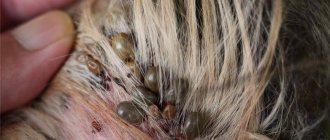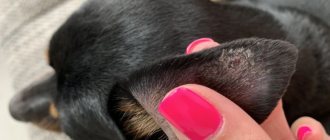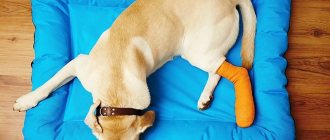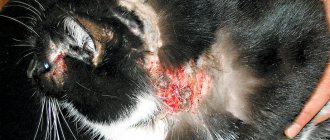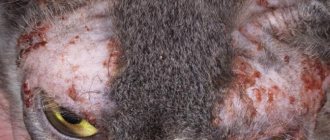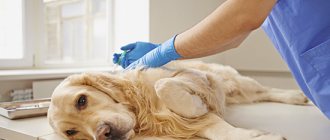05/09/2019 Drozd Nikolaevich Animals
The appearance of pimples on a dog's face always frightens the owner. After all, this not only spoils the appearance of the animal. In many cases, rashes are one of the signs of skin diseases, and sometimes pathologies of internal organs. How dangerous is acne? And how to improve the condition of your pet's skin? We will answer these questions in the article.
What do rashes look like?
Pimples on the face of dogs look like white or red bumps. They can be single, but often cover fairly large areas of the skin. Red rashes indicate inflammation, and whiteheads are a sign of suppuration.
Sometimes you can notice black pimples on a dog's chin. They look like little dots. These rashes appear due to clogged pores and are similar to human comedones. The appearance of blackheads most often indicates insufficient hygiene of the animal or an excess of fatty foods on the menu.
A photo of acne on a dog's face can be seen below. To understand the reasons for their appearance, you need to take a good look at the rashes and pay attention to your pet’s behavior.
Pimples on a dog's face photo
Of all the above, the danger lies only in juvenile cellulite, which requires special treatment with drugs.
Acne
Veterinarians use the word “acne” to describe all types of acne. The rash most often covers the chin, cheeks and lips. It is in these areas that a large number of sebaceous glands are located. Their ducts often become blocked and infected.
Acne can be a separate disease. The reason for its appearance is the following factors:
- Hormonal changes. Acne appears in puppies during the period of active growth and maturation. In adult dogs, acne can occur due to temporary hormonal imbalances.
- Features of the breed. Boxers, Pugs and Bulldogs are prone to developing rashes. Pimples on the lips are a common occurrence in dogs of these breeds. Dogs with a short muzzle are characterized by increased salivation. Their lips constantly get wet, and a humid environment promotes the growth of bacteria and fungi.
- Skin wounds. Even minor injuries (cuts, bites, splinters) can become a gateway for germs to enter.
However, acne very rarely occurs as an independent pathology. There are many skin and internal diseases that cause acne on the face of dogs. We will look at the causes of acne below.
Treatment
You can cope with the disease only if you have a diagnosis, since the cause may be allergies, bacteria, fungi, tumors, and so on. All of them require specific treatment.
The veterinarian will conduct the necessary tests and tests and prescribe the necessary medications. Most often, treatment is external, using special preparations, ointments and solutions. If there is an extensive bacterial infection, antibiotics may be prescribed; for allergies, antihistamines may be prescribed.
Hygiene, proper diet and restorative treatment are of great importance. The dog is given vitamins and special immunomodulators and immunostimulants, which are selected only by a specialist, based on the age and health of the patient.
Pimples on the face of dogs or the anus are an unpleasant phenomenon, but not because of the loss of attractive appearance, but because of possible diseases that provoke their appearance. To diagnose the nature of the formations and establish the root cause, the structure of the pimples, areas of the rash and the general condition of the pet are important.
Laboratory studies of scrapings and tweezers from affected areas make it possible to accurately determine what caused acne, make a diagnosis and prescribe treatment.
The scientific term anke is used to combine all manifestations of acne on the skin of animals. Veterinary practice has established that the muzzle: chin, cheeks, jowls are most susceptible to the threat of anke.
Purulent pimples on a dog’s face can be an independent disease that appears under the influence of the following factors:
- age-related changes in puppies - in the period of 5-8 months;
- hormonal imbalances in adults;
- hereditary predisposition;
- a feature of the breed - according to statistics, anke appears more often in boxers, pugs, bulldogs, and Rottweilers.
- skin injuries - splinters, cuts, insect bites.
It should be noted that in the scientific world, both veterinarians and doctors, based on research results, there is no consensus on the causes of acne as a separate disease, so the above factors still relate to a scientific hypothesis.
Identification of anke as a disease is possible based on characteristic signs:
- The appearance of red bumps or papules, as well as acne on the cheeks, chin, and jowls.
- Purulent discharge due to concomitant infection.
- Itchy skin, the animal scratches its face on objects and the floor.
Treatment of anke consists of washing with antiseptic agents, wound-healing compresses of calendula and chamomile, treatment with benzoyl peroxide ointments, and taking antibiotics for complications.
In most cases, anke manifests itself as a secondary disease, so if acne appears, it is recommended to conduct a comprehensive examination of the dog.
Pyoderma
Pyoderma is a purulent skin disease caused by staphylococci. The pathological process develops gradually. First, pimples form on the dog's face. They may appear as pustules, red bumps, or acne with a scaly texture. It is advisable to begin treatment when the first rash appears, since staphylococcal infection progresses very quickly.
Subsequently, darkening of the skin and the formation of scabs at the site of acne are noted. The dog is losing a lot of hair. Pyoderma causes severe discomfort to the animal. The pet is constantly itching, and sometimes whines in pain. The general condition also worsens, the dog becomes lethargic and inactive.
Causes of acne in adult dogs
Even experts don’t know the exact reason why dogs get acne. Modern medical research tends to believe that genetics plays a major role in the occurrence of acne. The following breeds are more often predisposed to rashes:
- German dog;
- English Mastiff;
- kurtshaar;
- Rottweiler;
- Doberman;
- French Bulldog;
- Yorkshire Terrier;
- Weimaraner;
- boxer.
Young dogs are more likely to suffer from acne; there are several main reasons:
- allergy;
- stress;
- genetics;
- poor immunity;
- lack of hygiene;
- poor quality nutrition;
- hormonal disorders;
- injuries;
- infections;
- fungal infections;
- ultraviolet radiation.
The main places for a large accumulation of pimples are the dog’s face, belly, paw pads, loop, anus. Less commonly, pimples are found inside the eyelid and on the inside of the cheek. Such manifestations are especially painful for the pet.
The main places where rashes accumulate are on the dog's face.
Important! If a rash of any nature is detected, it is advisable to contact a specialist as soon as possible. A timely diagnosis greatly facilitates the treatment of the disease and the well-being of the animal.
Ticks
Pimples on a dog's face can appear due to tick infestation. There are two types of parasitic diseases most often found in domestic animals:
- demodicosis;
- sarcoptic mange.
Demodicosis is a disease caused by the demodex mite. This parasite lives under the skin in the hair follicles. Often the disease begins with the appearance of pimples on the dog’s lips. Then all other parts of the animal’s face and body become covered with small red acne, which are very itchy. The pet itches often. Bacteria often get into scratches, which leads to the appearance of pustules. Demodicosis is often accompanied by noticeable hair loss.
Another common parasitic pathology is sarcoptic mange. The causative agent of the disease is the scabies mite. This microscopic parasite gnaws holes in the skin, which is accompanied by severe inflammation and irritation. The dog's skin turns red and becomes covered with small pimples. The pet suffers from severe itching. Often dogs with sarcoptic mange literally tear their skin with their claws. On the pet's face and body you can notice bald areas, as well as numerous scratches covered with crust.
Pyoderma
Another type of acne, which is provoked by pathogenic bacteria of the staphylococcal group and leads to inflammation of the skin.
Pyoderma appears on a dog’s face in stages. In the initial stage, the following appear: rash, papules, ulcers and inflammation of the skin, as well as roundness with a scaly center or epidermal collars. As the disease progresses, the skin darkens and becomes covered with scabs, all of which is accompanied by hair loss, itching and pain.
Lichen
Ringworm skin lesions are caused by pathogenic fungi. Of this group of diseases in dogs, dermatophytosis is the most common. At the initial stage, round pimples appear on the face. Subsequently, they spread throughout the body and become covered with scales.
The affected areas become bald and very itchy. The skin becomes dry and cracked. Often the dog has an unpleasant odor. Dermatophytosis is highly contagious and can be transmitted from animals to people.
A more rare form of lichen is pityrosporosis. This pathology is caused by yeast fungi. The pathogen lives on the skin of healthy dogs. With strong immunity, this does not cause damage to the epidermis. Ringworm appears only in weakened and old dogs.
Pityrosporosis is a serious disease. At the initial stage, the dog develops a rash that resembles acne in appearance. It is localized on the lips, ears, neck and in the space between the fingers. The animal's skin appears thickened and overly pigmented. Diaper rash appears with an extremely unpleasant odor. If the dog does not receive proper treatment, the fungal infection spreads to the ear cavity. This may cause deafness.
Acne in a dog
The article gives a general idea of this problem and ways to solve it, which are often used in practice. But it is always worth remembering that the nature of this and any other article from the Dog’s House project or other sites is information for information only, and not a guide to action.
This is due to the fact that animals, like people, must receive qualified assistance in matters relating to their health, so you only need to contact veterinarians in order to get the optimal result from the prescribed treatment.
Dog acne and itching, dandruff symptoms and treatment
Acne on a dog's body can be seen with the naked eye. If acne is not treated, the dog begins to actively itch. Depending on the complexity of the disease, treatment varies. At the site of the skin lesion, you need to cut off the hair and remove the crusts by treating with terramycin or hydrogen peroxide. Sometimes the animal is prescribed antibiotics. To increase the dog's immunity, homeopathic medicines are prescribed: gamavit or catozal.
When a dog has a skin disease, dandruff may appear, which causes discomfort in the dog. To begin treating dandruff, you need to identify the cause of its appearance. If there is large amounts of dandruff on the back, behind the ears, or on the sides of the dog, then treatment will take a long time.
Prayers
The right shampoo helps the sebaceous glands function normally, relieves irritation, and nourishes the skin. You can wash your dog using decoctions based on chamomile, nettle, and burdock. If dandruff is a consequence of poor nutrition, it is recommended to give your dog vitamin A.
If the cause of dandruff is a serious illness, then treatment is prescribed by a specialist.
Pimples in a dog in the groin, ears, lower abdomen, near the eyes, on the head, neck, hind legs, all over the body with pus, what to do and the reason
Pimples may appear in the groin of puppies if the bedding is wet or the puppy is not regularly groomed. It is enough to wash the dog well, wipe it dry and anoint it with a special cream. Pimples can also appear on the neck under the collar; you should let the dog stay at home without a collar.
Pimples with pus can appear on the head, near the eyes, stomach, and paws of short-haired dogs. If your dog has pimples all over his body, then this is an allergy. For food allergies, execan, vitamins and diet are prescribed.
After severe scratching, pimples with pus appear in the dog’s ears, the cause is eczema.
Purulent pimples on a dog’s face and back, like acne, bumps, how to treat at home
“Greasy tail” - accompanied by severe itching and after the first symptoms appear on the skin of the dog’s face or back, black dots - acne - are clearly visible. With this type of acne, it is important to maintain good grooming hygiene and clean the pores regularly. If the pimples look like lumps, you need to apply bandages from Vishnevsky ointment until the skin becomes completely thin. The dog's bandage needs to be changed 5 times a day; the bandage is removed only if there is no blood or pus coming from the wound.
Pimples in dogs under the arms, tail, fur
When a dog has allergies, itching begins and pimples appear in the armpits and tail.
Acne in a dog during heat, on the chin, from fleas, after trimming, itches, what to do
During estrus, the dog's appetite decreases, so immunity decreases, after which the animal may develop acne. Vitamins can help your dog at this time. Pimples appear on the chin as an allergic reaction to food, you need to change the food and give the dog suprastin.
If the cause of itching and pimples is fleas, then a solution with sulfur will help destroy them. If your dog is injured during trimming, acne may develop. The combed areas should be lubricated with an antiseptic and the dog should be given sedatives for several days.
Water pimples on a dog, on the eyelids, on the lips, small pustular pustules on the forehead, what to apply
If your dog develops water pimples, you need to lubricate them with Vishnevsky ointment.
Small pustular pimples on the forehead can be lubricated with Terramycin.
Add a comment Cancel reply
Other reasons
Acne appears not only due to skin and parasitic diseases. In some cases, acne is secondary. Rashes on the face can be a symptom of the following pathologies:
- Dysbacteriosis and intestinal inflammation. With diseases of the gastrointestinal tract, white acne forms in the animal. Pimples on a dog's beard most often occur as a result of pathological processes in the colon. Rashes on the cheeks indicate problems with the small intestine.
- Allergy. Dogs often experience allergic reactions to food, hygiene products, pollen and chemicals. This is accompanied by the appearance of small red pimples and spots, as well as itching and inflammation of the skin.
- Vitamin deficiency. If a dog's diet is unbalanced, this can cause vitamin deficiency. The lack of nutrients manifests itself in the formation of acne, deterioration of the coat and teeth.
Causes of acne
How exactly to treat acne on a dog’s stomach depends not only on the symptoms and clinical signs, medical history and condition of the animal. In the selection of treatment methods, the etiological factor—the causes of the disease—plays an important role. Acne can occur due to the following circumstances and factors:
- Attack of ectoparasites: lice, flies, mosquitoes, other insects;
- Attack of ticks, especially subcutaneous ticks, resulting in diseases such as demodicosis, sarcoptic mange;
- Infection with fungal pathogens that provoke the disease lichen;
- Negative effects of environmental factors: pollution, radiation exposure, solar radiation;
- The influence of toxic components contained in the air, food, care products;
- Exposure to allergens present in plant pollen, polluted water bodies, and air;
- Reaction to excess or lack of necessary ingredients in the dog’s diet;
- Reaction to sudden changes in temperature;
- Disruption of metabolic processes in the animal’s body at the cellular level or in tissues.
However, a common cause of the appearance of such rashes on the back or on the nose and lip can be an overdose of medications during treatment, frequent hypothermia, the consequences of certain viral diseases or the action of pathogenic bacteria.
How to get rid of rashes
It is almost impossible to independently determine the cause of deterioration of an animal’s skin condition. You need to take your pet to the veterinarian as soon as possible. The specialist will prescribe all the necessary diagnostic tests and tests. Treatment will depend on the diagnosis.
In most cases, treatment with external ointments and gels is sufficient. Their choice depends on the cause of the rash. For pyoderma, antibacterial agents are indicated, and for lichen, antifungal agents. Antibiotic-based ointments are also prescribed for scratching the skin and the appearance of pustules. In case of severe pyoderma and lichen, these drugs are also prescribed in the form of tablets for internal use.
Under no circumstances should you try to squeeze out pimples. Before contacting a specialist, you can only treat acne with iodine or brilliant green, and also wash the affected areas with a decoction of chamomile or calendula. Human ointments should not be used on dogs. After all, animals require a much lower concentration of medicinal substances.
For demodicosis and sarcoptic mange, anti-mite shampoos and drops are used. The affected areas are treated with ointments based on ichthyol and sulfur. In case of severe infestation, acaricidal tablets and injections are indicated.
If acne is caused by allergies, then it is necessary to protect your pet from contact with irritating substances, and also review the dog’s diet. To relieve inflammation and itching, antihistamine ointments and tablets are prescribed.
Source: fb.ru
How to help a dog at home
In addition to drug treatment for a dog prescribed by a veterinarian when acne is detected, the pet’s health can be significantly improved through special home care. An effective way to treat acne in dogs is with special bath products containing benzoyl peroxide. Compresses made from calendula solution are a great help in solving the problem of rashes, but before starting the procedure, you need to make sure that the animal does not have an allergic reaction.
To do this, apply a small amount of calendula tincture to the skin and monitor the reaction - normally there should be no redness or itching. You can’t use brilliant green and iodine to treat acne - they can lead to additional trauma to the skin, but they definitely won’t help solve the existing problem.
